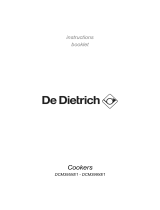
Instructions for the installer
11
This appliance can only be installed in ventilated rooms, according to current standards, so as to
allow, with openings onto external walls or appropriate ducts, for correct natural or forced
ventilation that permanently and sufficiently ensures both the air intake necessary for correct
combustion and the expelling of vitiated air. It is recommended that the appliance have a
rangehood fitted directly above or ceiling fan in close proximity to the appliance.
In all other cases, i.e. when other gas appliances are present in the same room, or, if it is not
possible to have natural direct ventilation, it is necessary to create natural, indirect ventilation or
forced ventilation: for this type of operation, it is necessary to contact a authorised person for
installing and creating the ventilation system in strict compliance with the guidelines set out
in current standards.
The openings should be positioned so as not to allow the formation of any unpleasant air current
for the occupants. Furthermore, it is forbidden to use flues already used by other appliances to
expel products of combustion.
3.6 Gas connection
We recommend checking that the appliance is properly set up for the type of
gas distributed. The connection to the gas pipes must be made in a
workmanlike manner, in compliance with current standards that prescribe the
installation of a safety tap at the end of the pipe. The Gas Connection is
male ½" BSP and is situated at the left hand, top rear of the appliance,
74mm from the side and 700mm from the floor (cookers) or 25mm from the
underside (cooktops). The appliance is factory set for Natural gas. The test
point pressure should be adjusted to 1.00kPa with the Wok and Semi-Rapid
burners operating at maximum on 120cm models and the Wok burner
operating at maximum on 90cm models.
For propane a pressure regulator set to provide a supply pressure of 2.75kPa conforming to
standards regulations in force should be fitted. The seals must conform to standards regulations in
force. Fit the test point assembly supplied with the appliance to the gas connection when installing
for use with Propane Gas. Once the gas has been connected, check the seal of the unions with a
soap and water solution.
It is possible to connect the gas in the following ways:
• using iron or copper rigid pipe as specified in AS5601 table 3.1;
• using a Plumbezy flexible hose, AGA approval number 6196, 10mm ID, class D and between
1-1.2m long in accordance with AG601 for a "high level connection". For cookers supplied with
a flexible hose the restraining chain fitted to the rear of the cooker must be fixed to the wall as
follows.
1. Supply fixing points on either side of the cooker (vertically in line with the chains attached)
at approxiametely 100mm above floor level.
2. Firmly secure the chains at these points.
3. Supply similar fixing points at approxiametely 700mm above floor level using open hooks.
4. Loop the chains over these hooks to prevent the cooker from accidentally tilting.
5. Removing the chains from the hooks enables the cooker to be pulled out for service. Ensure
that the chains prevent stress on the hose assembly while the cooker is in this position.
• Do not allow the pipes to be constricted or crushed;
• Pipes must not be subject to tractive force or torsional stress;
• Do not allow the pipes to come into contact with cutting or sharp edges, etc...
• Do not allow the pipes to come into contact with parts that can reach temperatures of 70°C
above room temperature;
• Make sure the entire length of the pipes can be inspected.
• Do not use the Natural Gas Regulator supplied with the appliance for Propane Gas.




















